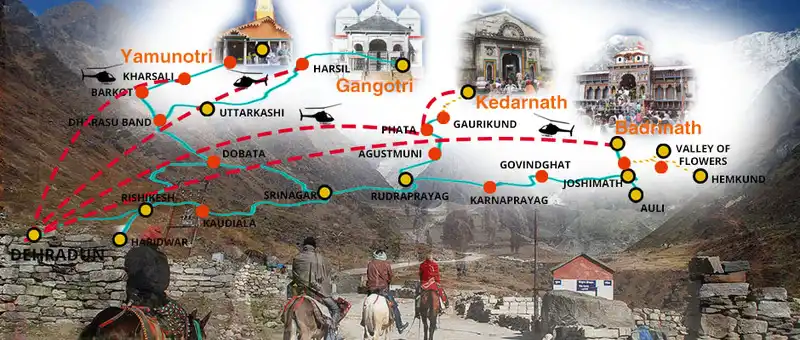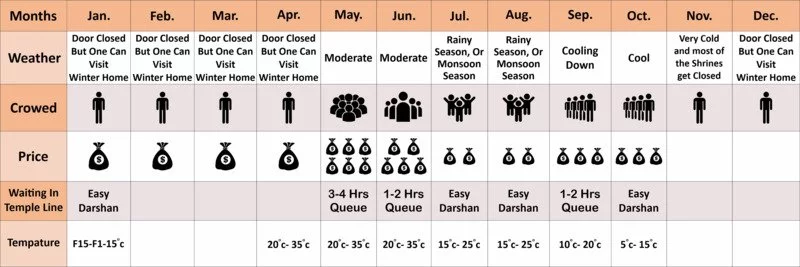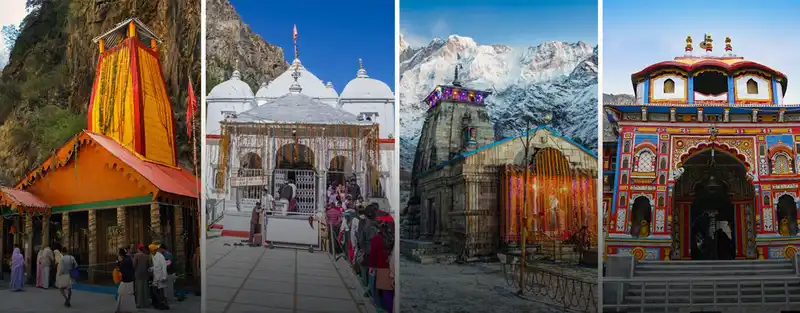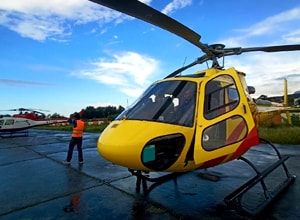Chardham Yatra 2025
Home »
About CharDham
 Nestled beautifully in the Himalayan ranges of the northern state of India, Char Dham Yatra encompasses four prime holy destinations. Yamunotri, Gangotri, Kedarnath, and Badrinath collectively form the Chota Char Dham circuit in Uttarakhand. These four sacred temples are located in four different directions of the state and are devoted to different gods and goddesses.
Nestled beautifully in the Himalayan ranges of the northern state of India, Char Dham Yatra encompasses four prime holy destinations. Yamunotri, Gangotri, Kedarnath, and Badrinath collectively form the Chota Char Dham circuit in Uttarakhand. These four sacred temples are located in four different directions of the state and are devoted to different gods and goddesses.
CharDham Route Map
 Also called as Devbhoomi, Uttarakhand houses the famous Hindu temples named Kedarnath, Badrinath, Yamunotri, and Gangotri. All four holy shrines are situated in different directions and are dedicated to different gods. All the four shrines are situated on extreme location amidst the lofty Himalayan ranges. The Yatra is considered to be the most devoted and spiritual journey of Uttarakhand. There are myriads of legends and histories related behind all the pilgrimages of Char Dham circuit where each enhancing the glory of the shrine. It is believed that the Char Dham Yatra was first started by the famous saint Adi Shankaracharya.
Also called as Devbhoomi, Uttarakhand houses the famous Hindu temples named Kedarnath, Badrinath, Yamunotri, and Gangotri. All four holy shrines are situated in different directions and are dedicated to different gods. All the four shrines are situated on extreme location amidst the lofty Himalayan ranges. The Yatra is considered to be the most devoted and spiritual journey of Uttarakhand. There are myriads of legends and histories related behind all the pilgrimages of Char Dham circuit where each enhancing the glory of the shrine. It is believed that the Char Dham Yatra was first started by the famous saint Adi Shankaracharya.
CharDham Weather
 The extreme location of these pilgrimages doesn’t allow devotees to cover this divine journey all throughout the year. The Yatra comprises of the spiritual visit to all the peaceful and enchanting pilgrimages seated in the Garhwal Himalayan Ranges. Kedarnath-the holy shrine of Lord Shiva, Badrinath- the holy abode of Lord Vishnu, Gangotri and Yamunotri –the originating places of the two holiest rivers in India collectively constitute the Char Dham circuit. Tourists covering this divine Yatra not only experiences spiritualism but also deep serenity and tranquillity spread in the ambiance of these regions and can also witness the rich cultures of the state.
The extreme location of these pilgrimages doesn’t allow devotees to cover this divine journey all throughout the year. The Yatra comprises of the spiritual visit to all the peaceful and enchanting pilgrimages seated in the Garhwal Himalayan Ranges. Kedarnath-the holy shrine of Lord Shiva, Badrinath- the holy abode of Lord Vishnu, Gangotri and Yamunotri –the originating places of the two holiest rivers in India collectively constitute the Char Dham circuit. Tourists covering this divine Yatra not only experiences spiritualism but also deep serenity and tranquillity spread in the ambiance of these regions and can also witness the rich cultures of the state.
CharDham Travel Tips
 All set to partake the divine Char Dham Yatra? We have come up with some of the essential tips to be followed including what sort of essentials is needed to be carried? What are the things which need to be avoided on the trip? Or what are the things which can be done on your Char Dham Yatra? Check the below-enlisted points to make your divine journey hassle free.
All set to partake the divine Char Dham Yatra? We have come up with some of the essential tips to be followed including what sort of essentials is needed to be carried? What are the things which need to be avoided on the trip? Or what are the things which can be done on your Char Dham Yatra? Check the below-enlisted points to make your divine journey hassle free.

6 Days / 5 Nights
Chardham Yatra by Helicopter
Starting @₹ 1,90,000₹ 2,09,000(10% OFF)
- Yamunotri → Gangotri → Kedarnath → Badrinath
- Cab Transfer
- Flights
- Helicopter
- Hotel Stay
- Meals
- Sightseeing

7 Days / 6 Nights
Teen Dham Yatra Package
Starting @₹ 28,400₹ 31,240(10% OFF)
- Badrinath → Kedarnath → Gangotri
- Cab Transfer
- Flights
- Helicopter
- Hotel Stay
- Meals
- Sightseeing

Same Day
Do Dham Yatra by Helicopter
Starting @₹ 99,000₹ 1,08,900(10% OFF)
- Dehradun → Kedarnath → Badrinath
- Cab Transfer
- Flights
- Helicopter
- Hotel Stay
- Meals
- Sightseeing

9 Days / 8 Nights
Gangotri Gaumukh Trekking
Starting @₹ 32,900₹ 36,190(10% OFF)
- Delhi → Gangotri → Gaumukh
- Cab Transfer
- Flights
- Helicopter
- Hotel Stay
- Meals
- Sightseeing

12 Days / 11 Nights
Chardham Fixed Group Departure
Starting @₹ 32,500₹ 35,750(10% OFF)
- Yamunotri → Gangotri → Kedarnath → Badrinath
- Cab Transfer
- Flights
- Helicopter
- Hotel Stay
- Meals
- Sightseeing
Frequently Asked Questions (FAQs)
Q.What is the Price of the Char Dham Yatra Tour Package?
A. Char Dham Yatra by Helicopter can cost an upwards of 1.4 lakh for 2 nights, Char Dham Yatra from Delhi by road can cost from 30,000 to 90,000 rupees for Do Dham Yatra to Char Dham Yatra of 10 days.
Q.Is Char Dham Yatra Open in 2025?
A. Yes. Uttarakhand government and the high court has lifted the ban on Char Dham Yatra keeping in mind the COVID protocols.
Q.How many Days it takes to Complete Char Dham Yatra?
A. It all depends on the mode you choose. Char Dham Yatra by Helicopter will take a maximum of 4 to 5 days. Char Dham Yatra from Delhi by Road will take 10 to 11 days to cover.
Q.Is Char Dham Yatra by Train Available?
A. Indian railways and IRCTC has come up with an IRCTC Char Dham Package in an attempt to make this pilgrimage more accessible to a wide range of people from all over India. It includes hotels, meals, transfers and Darshan to the temples of Badrinath, Jagannath Puri, Dwarkadhish and Rameshwaram. There is still no IRCTC package for Chota Char Dham Yatra of Uttarakhand.
Q.When is the Best Time to go for Char Dham?
A. The best time is to go either during the summer months of April to June and from September to November.
